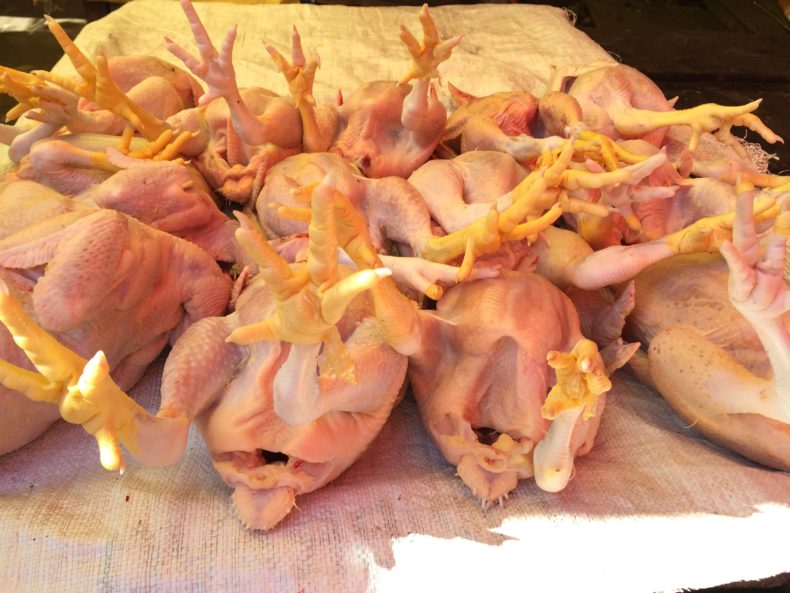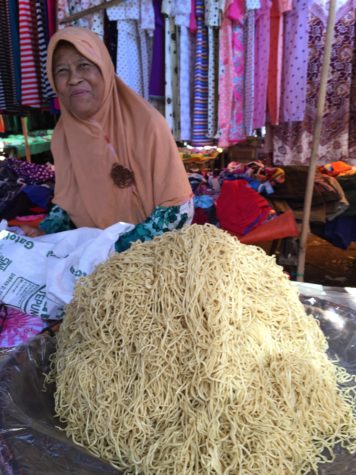
Change is good. And today, here on LWON, I’m announcing a personal change. I’m coming out. As a vegetarian.
Some of you may be surprised that I’m not one already. With my career focus on animals and conservation, and my adoration for all creatures great and small, it might seem wrong for me to eat cows and chickens and pigs. Once, a snotty 10-year-old kid at a talk I was giving asked if I was vegetarian and, when I said no, he chided me for this conflict of interest. (Really, kid? I could just hear his mother’s voice coming out of his mouth. This was in Seattle, after all.) I was annoyed and kind of wanted to punch him in the nose. But he was kind of right that I was mixing my messages. Love and respect animals, I was saying, but steak sure is tasty.
Most living things are food to some other living thing somewhere in the world. We hunt because our ancestors hunted, and because animals are nutritious. In many parts of the world, meat is a vital part of the human diet. Animal consumption is deeply cultural, usually healthful, and often celebratory.
Here in the West, though, we are often separated from our meat in a way that I think makes us dishonest. Most of us never see the animal as a whole as it is broken down into the parts we buy. What is displayed at Safeway is unidentifiable, already plucked and skinned, rinsed clean and trimmed, wrapped tidily to fit in the fridge and ready throw on the grill. Few people have to dismember a cow or wring a chicken’s neck. Not many of us raise a pig in order to slaughter and eat it. Maybe all kids should have to live on a farm for a few months before deciding whether to be carnivorous.
Unlike my local grocery store, the Saturday market in Tomohon, a village in north Sulawesi, Indonesia, is a brutally honest place. (I left out the graphic photos, but the descriptions herein may be unpleasant to some, so read on with caution.) Over on one table is a huge headless pig body, a bruised pink-yellow carcass spilling fat into sticky pools of blood. Next to it lies the animal’s lower end complete with hoofed feet and curly-Q tail, and look here, at its head, chopped from the body and left staring at the sky. The pig nose that just a day before was rooting in the dusty soil sniffs no more; the tongue flops from the open mouth like a flaccid flag on a windless day. All parts are for sale, and anything that can be eaten will be. You have to respect that nothing goes to waste.
The next table overflows with animals I’ve never thought of as edible: bats, forest rats, whole frogs (splayed and skewered like kabobs), python in fleshy hunks, and monkeys. At the far end of the stand a woman in a floral skirt, blood-spattered tee shirt, and flip flops holds a torch to the furry things, to burn off the unwanted layer. The smell of singed hair and flesh coats the senses, thick and foul.
The rows of bats are stacked three high, mouths open wide, resembling some eerie choir going for a high note. Their leathery wings (apparently also good to eat) are removed and piled like fabric scraps behind the bodies. And the monkeys. It is hard to look at those familiar faces, the bodies sectioned into fours, animals with DNA nearly identical to humans’ now bent and broken. From being held to the fire their lips are pulled back from their crooked teeth in a horrible grimace. The seller seems amused by my clear lack of comfort with these foods; she waves a leg at me, then works at propping two upper bodies to face me, one with a stiff arm around the other. She’s just being friendly, hoping for a smile.
Roaming the market are dogs, jackal like with pointed ears and curled tails, many of them blood speckled from standing so close to the butchers. I don’t see any being sold here as meat or, worse, in tiny cages for later slaughter. But I know what their fate will be. Today they snap up bloody scraps from the ground; tomorrow, they may be scraps themselves. Dogs are part of the traditional diet. And I’ve seen how dogs here are killed, a horrific scene I won’t describe so it won’t be lodged painfully in your mind like it is in mine.
I’ve visited markets like this one before, in other parts of the world. And I’ve always told myself that eating animals is just part of who we are as humans, that our ancestors hunted and so we hunt, that our bodies need the nutrients that meat give us. Who am I to judge what others choose to consume; why is a dog or a monkey a less valid source of protein than, say, a chicken breast or pork chop sizzling on my grill at home?
A new book by Marta Zaraska about the human obsession with meat suggests that we aren’t really built to be carnivores (e.g., we lack the right teeth); still, consider the following stats from her reporting:
According to the U.S. Department of Agriculture (USDA), in 2011 we ate an average of sixty-one pounds more of meat than we did in 1951—that’s about 122 average eight-ounce steaks a year more, despite all the accumulating warnings about cancer, diabetes, and heart disease. … Across the world, the appetite for animal protein is on the rise. The Organisation for Economic Co-operation and Development (OECD) estimates that by 2020 the demand for meat in North America will increase by 8 percent (as compared to 2011), in Europe by 7 percent, and in Asia by a whopping 56 percent. In China, meat consumption has quadrupled since 1980.
Pretty scary stuff, especially if you’re a cow. In Sulawesi, culture drives much of the meat eating, not hunger. (Enjoying meat is another driver.) That’s true here at home, too. We like the flavors of meat (and poultry) and we associate them with so many cultural experiences: summer BBQs have their juicy burgers, Thanksgiving is a turkey feast, Easter brings out the ham. A special outing to a nice restaurant? Order that tender filet mignon.
But many of us are fortunate to have a lot of choices; we can design our own diets, replacing one food with another. Nutrition can be bought in so many forms. Could we change those cultural norms, making alternatives to meat a part of new traditions? Some families are headed that way, but many meat lovers just don’t want to let go of their favorite proteins. (“Fake meat” is a thing now, though I think it’s still finding its legs.)
Meanwhile, our overly sanitized idea of food, of meat in particular, is bad for the environment, and certainly bad for animals. If every kid went to a market in Sulawesi and saw what meat looks like before it becomes a buffalo wing or McNugget, just imagine how the human diet might evolve. Same goes for visiting a factory farm in the U.S. [If I may, a quick shout out to the noodle lady at Tomohon (left). What a relief it was to find her just beyond the butchering tables.]
Then there’s the movement, still small but growing, to make protein-rich insects a more prominent part of the human diet. Buggy and wormy critters are already eaten in many countries, but they have yet to be widely farm-raised as food to begin replacing the vast, environmentally destructive livestock ranches that have become common around the world. I think for a burgeoning human population, this is a fantastic idea. Yes, I’m a fan of insects as living creatures and it would be disastrous to strip the landscape of them. But we can grow them. And I’d rather humans raised and ate crickets than pigs, caterpillars than monkeys, beetles than dogs. To farm them would mean vast savings in natural resources like land and water, and the reduced need for chemical inputs. For those who can get past the “ick” factor, it’s a win-win—access to a “green” protein without killing a single mammal or bird to get it. (Bug-o-philes may not like the idea of killing insects either, but I think it’s a step in the right direction.)
And of course, if I’m ever offered a plate of grasshoppers, I can politely, and legitimately, refuse. I’m a staunch vegetarian, you see.
—
Photos by the author